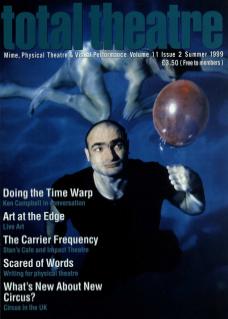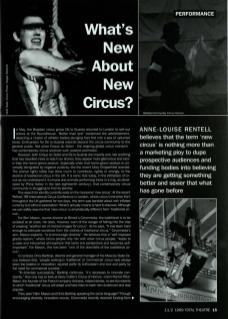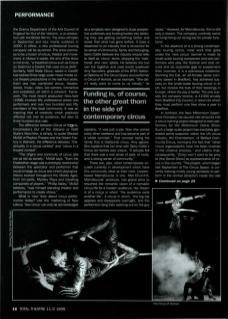In May, the Brazilian circus group De La Guarda returned to London to sell-out shows at the Roundhouse. ‘Better than sex!’ exclaimed the advertisement, depicting a cluster of athletic bodies plunging feet first into a sea of upturned faces. Enthusiasm for De La Guarda extends beyond the circus community to the general public. Not since Cirque du Soleil – the reigning global circus monarch – has contemporary circus received such positive promotion.
However, both Cirque du Soleil and De La Guarda are imports and, like anything that has travelled miles to reach our shores, they appear more glamorous and exotic than the home-grown product. Especially when that home-grown product is universally denigrated by negative publicity, like the recent Mary Chipperfield scandal. The animal rights lobby has done much to contribute, rightly or wrongly, to the decline of traditional circus in the UK. It is ironic that today, in the birthplace of circus as we understand it (humans and animals performing tricks in a ring, as developed by Philip Astley in the late eighteenth century), that contemporary circus community is struggling to find its identity.
This search for identity currently rests on the misnomer 'new circus'. At the recent Refract '99 International Circus Conference in London, where circus luminaries from throughout the UK gathered for two days, this term was bandied about with inflated currency but without explanation. What it actually means is hard to discover. Although I assume that 'new circus' is emphatically different from traditional circus.
For Bim Mason, course director at Bristol's Circomedia, the traditional is to be avoided at all costs. He does, however, warn of the danger of falling into the trap of creating ‘another set of cliched images for circus’. As he says, ‘It has been hard enough to extricate ourselves from the cliches of traditional circus.’ Circomedia's aim, Mason explains, ‘is to encourage diversity’. He believes that a ‘self-imposed ghetto-isation’, where circus people only mix with other circus people, ‘leads to a stale and introverted atmosphere that lacks any perspective and becomes self-important’. For Mason, this has been ‘one of the downfalls of the traditional circus’.
In contrast, Chris Barltrop, director and general manager of the Moscow State Circus, believes that, ‘people working in “traditiona” or “commercial” circus have always been the leaders in innovation, spurred partly by enthusiasm and love and partly by the need for commercial success’.
‘To entertain successfully,’ Barltrop continues, ‘it's necessary to innovate constantly.’ One only has to look at Gerry Cottle's Circus of Horrors, which Pierrot Pillot Bidon, the founder of the French company Archaos, helped devise, to see the extents to which traditional circus will adapt and take risks to seek new audiences and stay popular.
Then aren't Bim Mason and Chris Barltrop speaking the same language? Through encouraging diversity, innovation occurs. Circomedia recently received funding from the Drama Department of the Arts Council of England for Out of the Volcano, a co-production with the Bristol Old Vic. The show will open in September and tour mainly outdoors in 2000. In effect, a new professional touring company will be launched. The show promises to be a fusion of circus, theatre and movement. In Mason's words, the aim of the show is not to be, ‘a theatrical circus such as Cirque du Soleil but a theatre that uses circus skills’. Similarly, NoFit State Circus, based in Cardiff, has tackled three large-scale mixed-media circus theatre productions in the last four years. Each one has combined circus, theatre, dance, music, video, live camera, interactive and installation art within a coherent framework. The most recent production Now.here (1998) involved fifty professional artists and performers and over two hundred and fifty members of the local community. It was an inspiring feat of creativity which positively affected not only its audience, but also its three hundred plus cast.
The difference between Circus of Horrors, Circomedia's Out of the Volcano or Nofit State's Now.here, is simply, to quote Stewart McGill of Playbox Theatre and the Dream Factory in Warwick, the difference between ‘theatricality in a circus context’ and ‘circus in a theatre context’.
‘The origins and continuity of circus arts are as old as society,’ McGill says. ‘Even the Elizabethan stage was a prototype relationship between the spectator and performer that would emerge as circus and inherit playing traditions evolved throughout the Middle Ages, from inn-yards, Mystery Plays, and travelling companies of players.’ ‘Phillip Astley,’ McGill believes, ‘was himself blending theatre and performance to create shows.’
What is 'new' then about circus performance today? Like the marketing of New Labour, 'new circus' can only be acknowledged as a simplistic term designed to dupe prospective audiences and funding bodies into believing they are getting something better and sexier that what has gone before. It does a disservice to an industry that is renowned for its sense of community, family and belonging; Gerry Cottle believes the industry should refer to itself as 'circus' alone, dropping the 'traditional' and 'new' labels. He believes the two can live together and uses sword swallower Amy Saunders, graduate of the BTEC National Diploma at The Circus Space and performer in Circus of Horrors, as an example. ‘She didn't really want to come to us initially,’ he explains, ‘it was just a job. Now she comes every other weekend and has become part of a whole concept.’ That concept being the family that is traditional circus. Amy agrees. She explains that her time with Gerry Cottle's Circus of Horrors was unique. ‘It actually felt that there was a real sense of past, of roots, and a strong sense of community.’
There are, also, other contemporary circuses currently in development which have this community ideal at their core. London-based Mamaloucos is one. Mat Churchill, Mamaloucos producer, has grand aims to resurrect the romantic vision of a nomadic circus life for a modern audience. His dream is of ‘a circus in which the audience visits another life’. A circus in which, ‘the big top appears and disappears overnight, and the performers hang their washing out on the guy ropes’. However, for Mamaloucos, this is still only a dream. The company currently earns its living hiring out its big top for private functions.
In the absence of a strong contemporary touring circus, most work that goes under the ‘new circus' banner is made by small-scale touring companies and solo performers who play the festival and club circuits and do corporate gigs to supplement their incomes. It is a precarious existence. Skinning the Cat, an all-female aerial company based in Bradford, has achieved success on the small-scale touring circuit in the UK, but receive the bulk of their bookings in Europe, where the pay is better. The only subsidy the company receive is £1000 annually from Bradford City Council, in return for which they must perform one free show a year in Bradford.
In contrast, the New Millennium Experience Company has poured vast amounts into a circus training project designed to train performers for the Millennium Dome Show. Such a large-scale project has inevitably generated some suspicion within the UK circus industry. Wil Chamberlain, of Belfast Community Circus, bemoans the fact that ‘other circus organisations have not been involved in the creative process’, and claims that, consequently, ‘[theyl won't want to be privy to [the Dome Show] as representative of circus in this country’. The project, which began last September at The Circus Space, is currently training ninety young aerialists to perform in the central attraction inside the vast fifty-metre-high Dome in 2000. The fact that The Circus Space is hosting such a well-funded project, does, inevitably, not go unnoticed by a community which is historically so under-resourced.
Such negative reaction to a project that is considered, by others, to be a positive step forward for the profile of circus in the UK, is unfortunate in light of the exciting diversity and standard of training throughout the UK at this time, however. While The Circus Space develops the first ever degree in circus to commence this year, training centres like Belfast Community Circus, Skylight Community Circus in Rochdale and Broli at the Clocktower in North Wales use circus skills and performance to enable education, youth and community work. Jim Riley of Skylight states: ‘In the area of youth work and education we are finding a lot more demands for long-term youth work projects.’ At Belfast Community Circus, youth work is a high priority in such a fragmented society. However, this work needs high levels of state subsidy and, as Wil Chamberlain states, ‘social need as much as creative development should be part of any national funding policy’.
Funding is, of course, the other great thorn in the side of contemporary circus. While traditional circus has depended on its commercialism, 'new circus' is funding hungry. However, the funding of circus arts is currently less than 1% of the Arts Council of England's performing arts budget. As circus performer and teacher at The Circus Space, Deborah Pope quite rightly says: ‘The form of circus is being over-exposed, while it remains underdeveloped in this country.’
As a result of the Refract conference, it became evident that a concerted effort to pool resources towards a coherent sense of circus for today is necessary. As Teo Greenstreet, chief executive of The Circus Space, says: ‘It is that word “circus” and how we affect people's understanding of it that is fundamental to where we are going. Also fundamental is a sense of unity within the circus community itself.’ A decision was made at the end of the conference to take positive action towards a national circus forum. This forum will aim to meet regularly to enable communication, to support training and performance standards, to raise the profile of circus as a performing art, to attract audiences and funding at regional levels, and to lobby for better sites for touring circuses.
As Deborah Pope says: ‘We have a rich and vibrant artform in our hands and I think we should just take it and go out there with it.’ Perhaps a new sense of identity is just around the comer.


